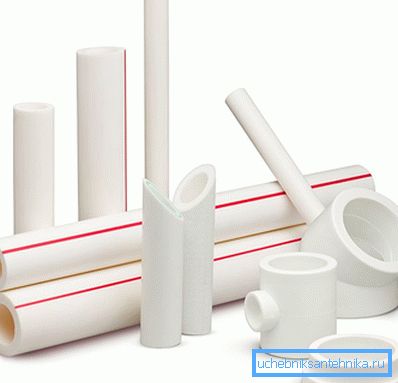How to bend a polypropylene pipe
Arrangement of various systems in a suburban area - whether it is plumbing, sewage or drainage system require not only insulation or insulation of pipes located in a house or on the street, but also the organization of constructive turns, due to the design of the house or features of the terrain.
During construction and repair work, polypropylene pipes are increasingly being used. Unlike metal, they have such undoubted advantages as:
- High strength and resistance to the effects of both atmospheric phenomena and soil. Polypropylene used as a material for pipes is not subject to corrosion or rotting. Systems assembled from polypropylene pipes have a service life of at least 25-30 years.
- Low weight building material. Polypropylene pipes are lightweight, which makes it easy to install them by hand.
- Easy way to connect polypropylene pipes using fittings and special devices.
- High environmental properties of a building material: polypropylene pipes do not have any negative effect on the fluid passing through them. This is due to their widespread use for arranging water supply systems.

During the laying or repair of pipes it is sometimes necessary to arrange the rotation of the pipe. Some turns can be realized with the help of fittings, however sometimes it is more preferable to learn how to bend a polypropylene pipe and perform a simple bend.
When arranging plumbing, sewage or drainage systems on their own, the owners ask if it is possible to bend pipes made of polypropylene. Manufacturers of polypropylene pipes do not recommend bending products, however, as it turns out in practice, bent pipes do not lose their properties if the operation is performed correctly.
Pipe bending methods
There are several ways to bend a polypropylene pipe:
- With the help of a building hair dryer.
- With the help of a molding machine.
- "Cold" bend pipes with their own hands.
Construction dryer
In order to bend the pipe at the right angle using a building hair dryer or a gas burner, you will need:
- construction dryer or gas burner;
- template of any solid material having the desired angle.
Originally required to make a template with the desired bend angle. It will be required to hold the polypropylene pipe in a previously prepared position. It is necessary to pay attention to the flat surface of the template along the entire length of the bend - this will help to maintain the flat surface of the already bent pipe and avoid bends, chips or dents.

On a polypropylene pipe with a pencil or marker, you should mark the area of the future bend. It is desirable that the length of the template matches the length of the intended pipe section of polypropylene.
The building dryer or gas burner is installed in such a way that a piece of polypropylene pipe can be brought to it without special difficulties. When working during heating, it is necessary to carefully and smoothly move a section of pipe made of polypropylene so that it heats evenly along the entire working length of the bend section.
Tip! Heating the pipe with a gas burner, you must act very carefully and do not bring the product made of polypropylene too close to the polypropylene pipe does not catch fire.
Having heated the pipe to the state when it can already bend, but has not yet melted and has not lost its shape, it is required to put it on the prepared template and fix it carefully. On the template, keeping the shape given to it, the heated pipe cools down to full hardening. After which it can be used for installation of the system or in repair work.
Molding machine
For this you will need:
- fibreboard
- silicone,
- molding machine
- sandpaper.
First, the frame is made of fibreboard. C using sandpaper on the frame removes all the notches, it is given a smoothness. The silicone molding machine produces a silicone mold with a diameter slightly larger than the diameter of the polypropylene tube, into which the latter will be placed.

The pipe in silicone form, mounted on a rim of fibreboard, is placed in a molding machine to heat to the desired temperature. The softened section of the pipe will lie gently on the bend of the prepared rim. After that, you can pull the pipe out of the molding machine and leave it until it cools completely. The cooled product must be removed from the frame and silicone mold and used for its intended purpose.
Cool way
This method is considered the most difficult - because it is during its execution that you can spoil the building material from polypropylene. If possible, experts recommend using the first two methods to bend polypropylene pipes.